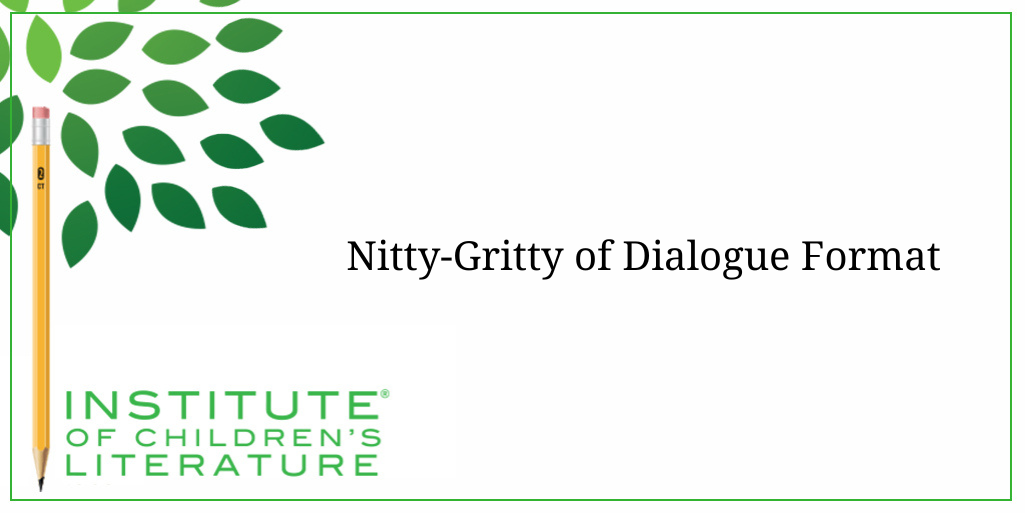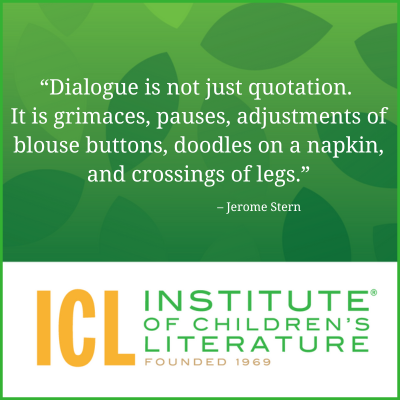
5 Ways Writers Can Prep for 2025 Goal Setting
Before we roll on to the new writing year, let’s harness our optimism for the blank slate before us and prepare for our 2025 Goal Setting just for writers.

Some of this is going to be old news to many of you, but I’m constantly surprised to learn just how complicated dialogue format is to writers. How do you handle paragraph breaks for dialogue? How do you handle punctuation? What’s the difference between a tag and an action beat? How do things change when you move the tag around? Should you use he said or said he, and does it make any difference? What if my character is monologuing for a long, long time? Also, we already looked at internal dialogue but we’ll have a tiny reminder here.
There may be more here than you think, so buckle up and let’s look at dialogue format.
Look at this very basic bit of dialogue:

“I don’t like this so big,” her sister said. “It doesn’t look cute when it’s big.”
Ruth sniffed. “Suit yourself.”
One of the immediate things to notice about this dialogue is that the punctuation for the spoken bits occurs inside the quotation marks. That’s a rule to keep in mind as you’ll see it in play in the examples that come later.
Notice also that I used [character] then [mode of speech] in the speech tags. That’s the order you’ll see in the bulk of dialogue today. In fact, it is so prevalent that reversing it and writing it as [mode of speech] then [character] tends to sound old-fashioned.
“Eat your peas,” Mother said. <– more common today.
“Eat your peas,” said Mother. <– more old-fashioned.
Now, you may choose the more old-fashioned voice of [mode of speech] then [character] intentionally to give your writing a fairytale voice or a sense of being from the past. In that case, it’s a specific, intentional choice, which is fine. But it’s good to be aware that it is a choice that comes with an old-fashioned feel that may conflict with a contemporary story.
One of the first things to know about dialogue is that you break for a new paragraph when you change speakers. My previous example demonstrated that. This is a signal to readers to help keep the speaker quite clear. Let’s look at how a professional handles this in a quote from Gordon Korman’s The Superteacher Project:
Ainsley Watanabe reads my mind. “I guess your rule-wrecking career is over, Oliver. Did you catch Mr. Aidact snatching your spitball out of the air? I’ve never seen anyone move that fast!”
“It was a fluke,” I scoff.
“You hope,” Rosalie challenges, looking pleased with herself. “School’s barely even started, and our homeroom teacher has already figured out you’re trouble.”
I shrug. “Who cares about homeroom? Twenty minutes at the start of the day when nobody’s even really awake. Trust me–rule-wrecking is about to have its best year ever!”
In this section, we have three different speakers, but Korman makes who is speaking extremely clear in a variety of ways. One is through breaking for a new paragraph when the speaker changes. This is a small thing but one of the easiest ways to make the speaker clear. But paragraph breaks aren’t all we can learn about format from this section. Let’s look at what this shows us about the difference between a speech tag and an action tag (or action beat).
When you are using a speech tag to identify the speaker, you are offering the character’s name (or pronoun) and the mode of speech. From the quote above, we can see these two speech-tagged sections:
“It was a fluke,” I scoff.
“You hope,” Rosalie challenges, looking pleased with herself.
Notice how the actual spoken words and the speech tag make up a single sentence. That’s why there is a comma and not a period between the spoken words and the speech tags. So, words spoken plus how they are spoken are one sentence. The punctuation for this reflects that, even when the tag comes first, comes last, or comes in the middle. Let’s look at that in action:
Mom whispered, “Come over here and give me a hug.”
or
“Come over here,” Mom whispered, “and give me a hug.”
or
“Come over here and give me a hug,” Mom whispered.
Now you can see something interesting here. Whenever you begin with your speech tag and follow with a quote, you begin the spoken words with a capital letter. That can seem strange as it conflicts with the idea of quote and tag being all one sentence, but whoever said grammar, capitalization, and punctuation weren’t strange?
There are a couple variants of this punctuation rule that you should know. One involves when the sentence is a question:
“Did you do that?” Bob asked.
Bob asked, “Did you do that?”
“Did you,” Bob asked, “do that?”
Questions need question marks to make sense, so the normal punctuation required of dialogue (the comma or a period) is exchanged for the question mark. Don’t try to fit in both the comma and the question mark. The question mark is replacing the comma or period.
The other variation involves when the tag separates two complete sentences or complete thoughts. In that case, you would tag like this:
“Come over here,” Mom commanded. “And don’t drag your feet either.”
“Come over here” is a complete thought. It’s a command. Also, “Don’t drag your feet either” is a complete thought, being another command. Because the first part of the bit of dialogue can stand on its own as a complete sentence, then it plus the tag are treated as a single sentence unit (with a period) and the next bit in the quotation marks begins with a capital letter and is treated like its own sentence. This is all down to that first bit being a potential complete sentence.
Let’s return to our Gordon Korman quote and look at how dialogue format changes when you use action to identify the speaker:
I shrug. “Who cares about homeroom? Twenty minutes at the start of the day when nobody’s even really awake. Trust me–rule-wrecking is about to have its best year ever!”
Shrugging isn’t a mode of speech, so it isn’t part of the dialogue sentence. Instead, it is its own sentence. This holds true even when the action tag or action beat comes in the middle of the dialogue or at the end. Look at how this works with a different bit of dialogue.
Jenny stomped her foot. “I wanted that. You’re mean.”
“I wanted that.” Jenny stomped her foot. “You’re mean.”
“I wanted that. You’re mean.” Jenny stomped her foot.
The stomping is always an action and will always be treated like a separate sentence. This kind of identifying the speaker via action is treated as a separate sentence, even if it breaks the dialogue in the middle of a sentence. To make that clearer, let’s look at an example:
“Did you?” Bob gave Pete a good shake. “Steal from me?”
Because this looks a bit awkward, you’re probably not going to want to do a lot of it and may want to tinker with the speech to avoid it. But sometimes it’s exactly the moment that the action occurred, so that’s when you insert it. Identifying speakers through action is a good way to help readers see the scene while also hearing it in their minds.
Dialogue tags include very common words like said, asked, replied, insisted, demanded, and the like. They can also include unusual words like challenged, scoffed, sneered, prevaricated, pontificated, and exposited, but keep in mind that you don’t actually want your tag to be more attention-getting than the dialogue it identifies, so don’t throw your thesaurus at your writing in an effort to keep your tags interesting. The interest should be in the dialogue itself. The tag is there to assist the reader, not show off your vocabulary.
Action on the other hand involves anything that isn’t a mode of speech. So that covers a lot of ground, but if the identification you’re using isn’t a mode of speech, then punctuate it like action. Look at this series of exchanges:

photo credit: canva
She smiled. “I do like you.”
He glared at her silly face. “When I’m doing what you want.”
“You always do what I want.” She patted his cheek.
He slapped her hand away. “Because I want it too.”
Notice that smiling isn’t a mode of speech. Neither is laughing. Now some words can be modes of speech in very specific types of dialogue. Let’s consider one:
He bent over and half covered his face with his hand. “Liar,” he coughed.
In this setting, he’s doing that thing where you cough out a word. It doesn’t work for long complex sentences. It only works for single exclamations, but in this specific instance, it is actually a mode of speech, even though it wouldn’t normally be.
This is another such situation.
He stumbled out of the woods. “Help,” he gasped.
Again, gasping doesn’t work for long speeches. Choose such speech tags carefully. If you can’t gasp out the word or hide it in a fake cough, then don’t use those as speech tags. If you cannot hiss a word because it contains no s-sounds, then don’t use hiss as a tag simply because it sounds mean. Always think about the speech tags you are using. Do they convey something that bit of speech specifically needs (if not, said would probably be a better choice)? And do they make sense?
Mostly in kidlit, we don’t write a lot of monologues, but sometimes they are exactly what you want. The punctuation for a multi-paragraph bit of dialogue is special. It’s signaled by not closing the quote between paragraphs to show that it’s going to continue into the next one. Here’s an example:
Peter stood up straight and clenched his hands to keep himself from waving them around. Then he began his report. “The history of Ambling Green began a long time before anyone in this room was born. My grandpa says that’s why everyone gets it wrong and thinks the village was named after the green patch right in the middle of everything. That’s not the way it was.
“Grandpa told me that Michael Greene, the founder of the village, was a tramp. That means he didn’t stay in one place very long. One day he decided to stop travelling, or ambling, and set up a village. That village is Ambling Green.” Peter bowed and waited for the applause. It didn’t come.
Even though the dialogue is broken in the middle, you start the second paragraph with a quotation mark, because we only needed one signal that this was a monologue, and that came at the end of the first paragraph by leaving off the quotation mark.
And though we’ve mentioned this previously, keep in mind that quotation marks and other punctuation rules apply to spoken dialogue. Thoughts are not put in quotation marks. They are signified by italics. A mix of dialogue and thoughts might look like this.
Joel doubted Mary had ever been dirty in her life. Dirt would be scared of touching her. I know I am. “Do you wash off the bottom of your shoes at night?” he sneered.
There are the basic guidelines for formatting dialogue. Since we can all use a refresher now and then, I hope you’ve found it interesting. Personally, I love thinking about the way language is put together as a writer it’s a very clever puzzle.
With over 100 books in publication, Jan Fields writes both chapter books for children and mystery novels for adults. She’s also known for a variety of experiences teaching writing, from one session SCBWI events to lengthier Highlights Foundation workshops to these blog posts for the Institute of Children’s Literature. As a former ICL instructor, Jan enjoys equipping writers for success in whatever way she can.

Before we roll on to the new writing year, let’s harness our optimism for the blank slate before us and prepare for our 2025 Goal Setting just for writers.

Writers can be thin-skinned when it comes to getting feedback on their work. Let’s look at 4 ways to positively deal with constructive criticism!

Rejection is part of the territory when it comes to being a writer. Today we offer reflection for writers to help redirect your efforts after a rejection.
1000 N. West Street #1200, Wilmington, DE 19801
© 2024 Direct Learning Systems, Inc. All rights reserved.
1000 N. West Street #1200, Wilmington, DE 19801
© 2024 Direct Learning Systems, Inc. All rights reserved.
1000 N. West Street #1200, Wilmington, DE 19801
© 2024 Direct Learning Systems, Inc. All rights reserved.
1000 N. West Street #1200, Wilmington, DE 19801
© 2025 Direct Learning Systems, Inc. All rights reserved.
1000 N. West Street #1200, Wilmington, DE 19801
©2025 Direct Learning Systems, Inc. All rights reserved. Privacy Policy.
6 Comments
I’m going to recommend this to my students as another great resource!
This covers the art and science of handling dialogue. I’m going to share it with my students.
I am having the hardest time between past tense and present tense wording. My second course, and I’m close to finishing the second course. I also plan on taking the third one. I wish you offered a class in past tense and present tense along with first, second, and third-person POV. I had no clue until I went on you to and found a wonderful video on what they mean. They offer to class, and I looked into it. I wish you would put together at least a video that explains first, second, and third-person POV if you offered a class combining past tense and present tense with POV or past and present tense on its own. In great detail. That is a class I would pay for. Thank you
PS If for some reason you’re not going to do this, would you please tell me where I could go to learn past tense and present tense?
Hi Dennis! Great question. Here are other blog posts that deal with POV:
Choosing a Point of View: https://www.instituteforwriters.com/choosing-a-point-of-view/
Polishing the Point of View: https://www.instituteforwriters.com/polishing-the-point-of-view/
Achieving Deep POV: https://www.instituteforwriters.com/achieving-deep-pov/
Using POV to Build Emotion: https://www.instituteforwriters.com/using-pov-in-writing-to-build-emotion/
Here are blog posts that deal with tenses:
3 Tricks to Getting Out of a Writing Rut: https://www.instituteforwriters.com/3-writing-tricks-to-get-out-of-a-rut/
Before You Submit: https://www.instituteforwriters.com/before-you-submit-your-writing/
Super helpful. Bookmarking this for future reference. Thank you!